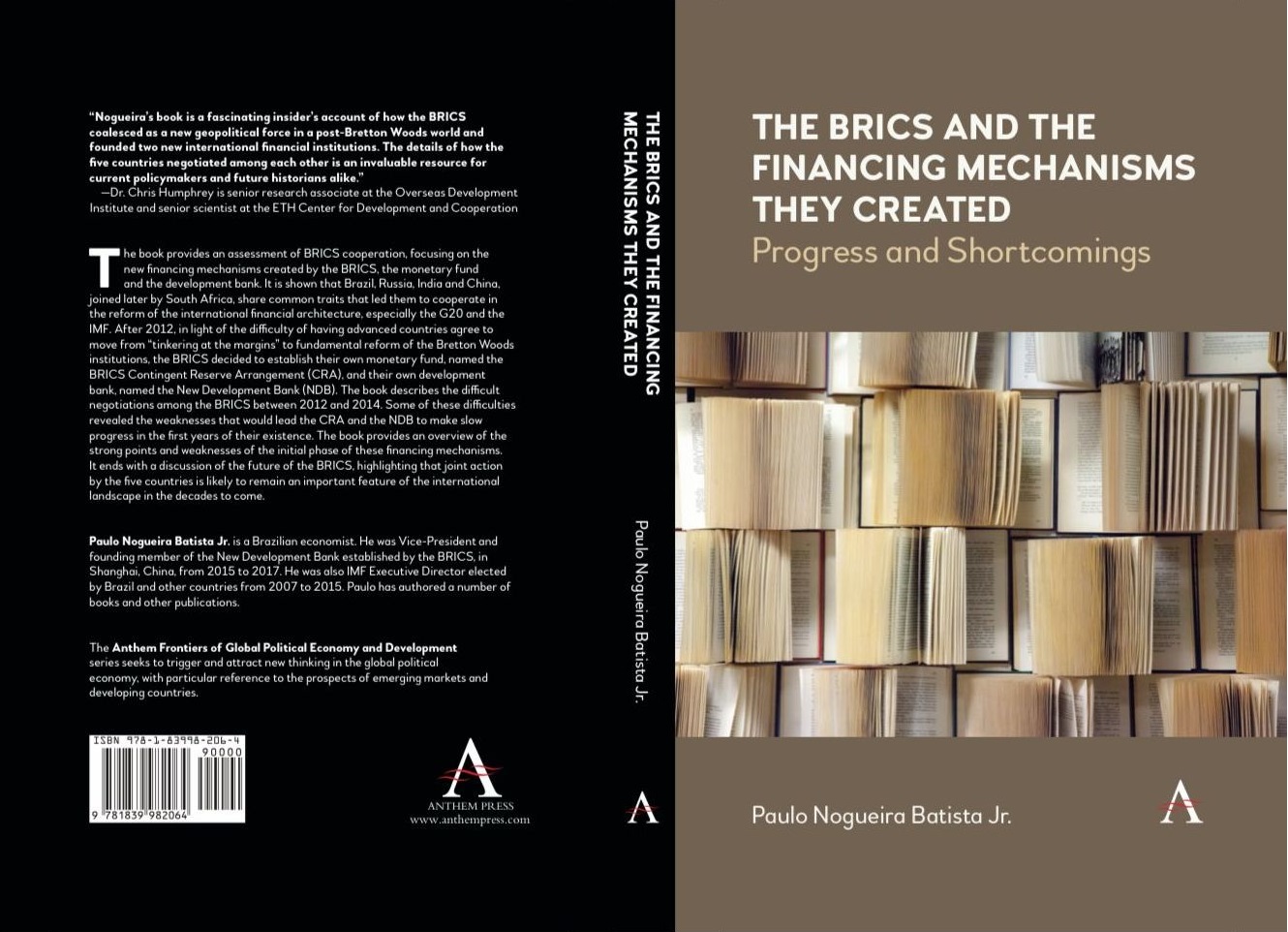Evaluating the BRICS Financing Mechanisms: Q&A with Paulo Nogueira Batista, Jr
Progress and Shortcomings: The BRICS and the Financing Mechanisms They Created
The BRICS and the Financing Mechanisms They Created
The BRICS and the Financing Mechanisms They Created

An insider’s account of the BRICS process and of the negotiation and implementation of the monetary fund and development bank BRICS created
“Nogueira’s book is a fascinating insider’s account of how the BRICS coalesced as a new geopolitical force in a post-Bretton Woods world and founded two new international financial institutions. The details of how the five countries negotiated among each other is an invaluable resource for current policymakers and future historians alike.” — Dr. Chris Humphrey is senior research associate at the Overseas Development Institute and senior scientist at the ETH Center for Development and Cooperation
The book provides an assessment of BRICS cooperation, focusing on the new financing mechanisms created by the BRICS, the monetary fund and the development bank. It is shown that Brazil, Russia, India and China, joined later by South Africa, share common traits that led them to cooperate in the reform of the international financial architecture, especially the G20 and the IMF. After 2012, in light of the difficulty of having advanced countries agree to move from “tinkering at the margins” to fundamental reform of the Bretton Woods institutions, the BRICS decided to establish their own monetary fund, named the BRICS Contingent Reserve Arrangement (CRA), and their own development bank, named the New Development Bank (NDB). The book describes the difficult negotiations among the BRICS between 2012 and 2014. Some of these difficulties revealed the weaknesses that would lead the CRA and the NDB to make slow progress in the first years of their existence. The book provides an overview of the strong points and weaknesses of the initial phase of these financing mechanisms. It ends with a discussion of the future of the BRICS, highlighting that joint action by the five countries is likely to remain an important feature of the international landscape in the decades to come.
O Brasil não cabe no quintal de ninguém
Apresentação sobre os temas do meu livro “O Brasil não cabe no quintal de ninguém”, janeiro de 2020. Duração: 20 minutos.
RESENHA: “O BRASIL NÃO CABE NO QUINTAL DE NINGUÉM:
Lisandra Pereira Lamoso
Universidade Federal da Grande Dourados
O Brasil não cabe no quintal de ninguém”, é um dos finalistas da segunda fase do Prêmio Jabuti 2020 na categoria Ciências Sociais

No livro, Paulo, um dos maiores economistas brasileiros, relata os bastidores da sua passagem por duas importantes instituições internacionais, o FMI e o banco de desenvolvimento criado pelos BRICS. A ideia central do livro é o nacionalismo – a persistência na defesa dos interesses do país e a convicção de que o Brasil não cabe no quintal de ninguém.
Garanta seu exemplar com desconto em www.casadosmundos.com.br!
https://www.instagram.com/p/CHOZ27KgCqt/?utm_source=ig_embed&utm_campaign=loading
Livro de cabeceira (nova definição)
Tenho escrito, em 2020, exclusivamente sobre temas de ordem pública, nacionais ou internacionais, econômicos e não-econômicos. Acredito que conquistei o direito de voltar a ser hoje um pouco mais pessoal. Pode ser? O leitor ou leitora não tem como, de certo, responder diretamente, mas pode parar de ler aqui. Espero que não o faça, e prossigo.
No final do ano passado, lancei um livro – O Brasil não cabe no quintal de ninguém: bastidores da vida de um economista brasileiro no FMI e nos BRICS e outros textos sobre nacionalismo e nosso complexo de vira-lata. Transcrevi o longo subtítulo, pois dá uma boa ideia do que é o livro. Trata-se da obra mais pessoal que publiquei até agora, superando o meu até então preferido – Da crise internacional à moratória brasileira, publicado em 1988 pela editora Paz e Terra –, que relata minha participação no governo brasileiro entre 1985 e 1987 e, em especial, na polêmica suspensão de pagamentos da dívida externa, decretada em fevereiro de 1987. Repare, leitor ou leitora, que os meus dois livros prediletos, dos tantos que publiquei, são frutos de vivências práticas e sofrimentos – não sou, nunca serei, um teórico, dado a reflexões abstratas em uma torre de marfim qualquer. E, houve sofrimento, sim, nas duas experiências, na mais recente, assim como na mais remota.
Ler maisLivro de cabeceira (nova definição)
Comentário sobre a escassa repercussão na minha família de “O Brasil não cabe no quintal de ninguém”, meu livro mais recente.
